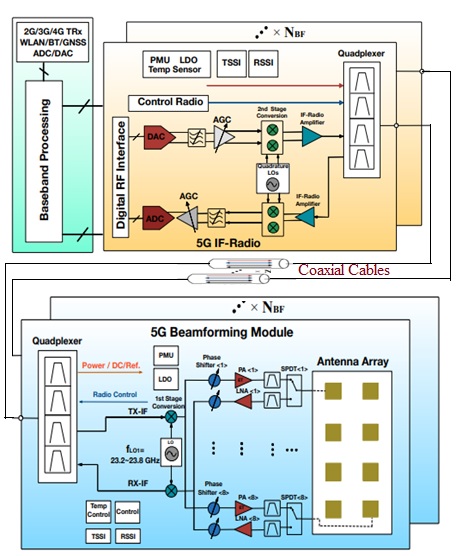5G Cell Phone Architecture | 5G Cell Phone Block Diagram
This article on 5G Cell Phone architecture covers 5G Cell Phone Block diagram with internal modules of 5G Cellular phone architecture.
Introduction:
5G cell phones have been designed to comply either 3GPP NR or Verizon TF specifications. Some phones support both of these specifications. It works on radio frequencies in various bands as per country wise allocations. Typically it uses less than 1 GHz, below 6 GHz and above 6 GHz (i.e. mmwave) frequency bands.
5G cell phones have been designed to comply either 3GPP NR or Verizon TF specifications. Some phones support both of these specifications. It works on radio frequencies in various bands as per country wise allocations. Typically it uses less than 1 GHz, below 6 GHz and above 6 GHz (i.e. mmwave) frequency bands.
It delivers fast uplink/downlink throughput due to massive MIMO and lower latency between 5G network (i.e. 5GNB) and itself. The 5G cell phone supports 10 times throughput compare to 4G phones. They are backward compatible to 4G standards viz. LTE and LTE-advanced. Moreover latest 5G phones will support bluetooth, wifi and NFC based short distance wireless technologies. GPS is also incorporated to support various GPS based applications including location tracking, google maps etc.

The figure-1 depicts block diagram of the GSM cell phone. As shown it consists of RF part including RF Transceiver chip, baseband part comprising of DSP and CPU for controlling the data/control messages. ADC/DAC chips are used for interfacing both RF and baseband parts. The other basic cell phone components include touchscreen display, battery, RAM, ROM, RF antenna, MIC, Speaker, camere, diplexer, micro-USB, SIM slots and more.
5G Cell Phone Architecture
The figure-2 depicts basic block diagram of 5G cell phone architecture. As shown the architecture include baseband part, digital RF interface such as DigRF, ADC/DAC and RF Transceiver. The basic components are same in the 5G phone except antenna array is used instead of one antenna to support massive MIMO and beamforming.
Quadplexer is used instead of diplexer to support multiple bands. Quadplexer or Quadruplexer is used to multiplex and demultiplex four radio frequencies to/from single coaxial cable as shown. This helps in reducing cost and weight as well as uses very smaller area of the phone. This shown 5G cell phone architecture supports mmwave frequency bands.

In order to support massive MIMO/beamforming multiple PAs, LNAs, phase shifters, RF filters and SPDT switches are incorporated in the 5G cell phone design. The 5G phone is backward compatible to 2G/3G/4G, WLAN, Bluetooth, GNSS etc. The 5G phone shown is based on heterodyne architecture and advantages of Heterodye receiver.
Radio Frequency Front End (RFFE) control signals are used to carry TSSI and RSSI informations. TSSIstands for transmitter signal strength indicator and RSSI stands for receiver signal strength indicator. As a result, the temperature control of the beamforming module and its calibration are performed.
PMUs (Power Management Units) and LDOs (low drop-out regulators) are used in beamforming part of the 5G cell phone. They transform DC voltage of coaxial cable to different power supplies for use in various dies for cell phone operation.
Note: The figure has been taken from the paper on "5G Cellular User Equipment: From Theory to Practical Hardware Design" which is published on July 18,2017 at IEEE Access by YIMING HUO1, XIAODAI DONG1 and WEI XU2.
No comments:
Post a Comment